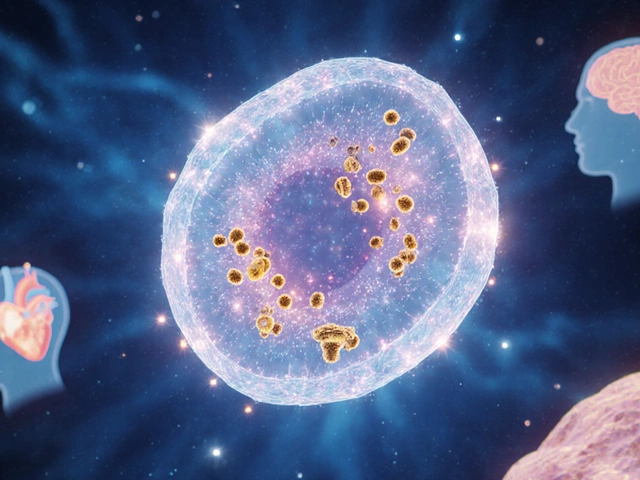Mental health is a topic that's getting a lot more attention these days, and for good reason. You might have heard about mental disorders, but knowing what they really are and how they affect people can be game-changing. Recognizing the signs and types can make a big difference for anyone dealing with these issues. Let's talk about seven of these disorders that often pop up in discussions.
One major group of mental disorders is anxiety disorders. Picture this: you're going through your day and suddenly, without any clear reason, your heart starts racing, and an overwhelming sense of worry takes over. That's what someone with an anxiety disorder might experience frequently. It's more than being stressed about an exam or a big meeting—it can be persistent and debilitating.
Introduction to Mental Disorders
When we talk about mental disorders, we're looking at a range of conditions that affect a person's thinking, feeling, mood, ability to relate to others, and daily functioning. It's more common than you might think. According to the World Health Organization and studies by mental health centers, one in four people around the globe will be affected by mental or neurological disorders at some point in their lives.
Mental disorders vary widely in their symptoms and impacts. Some can be mild and temporary, while others may be more severe and long-lasting. They can affect anyone, regardless of age, gender, or background. Common types include anxiety disorders, mood disorders like depression, and personality disorders.
Symptoms and Impact
While it might be easy to say "it's all in your head," mental disorders can have serious tangible effects. Symptoms can range from changes in mood and behavior to full-blown physical issues like chronic fatigue or pain. They can seriously interfere with daily life, making even simple tasks feel overwhelming.
Mental health is fast becoming a topic of intense focus in the healthcare realm because of its direct link to overall wellbeing. It's no longer just about mental "illness"—people are recognizing the need for maintaining mental wellness just like physical health.
Why Understanding Matters
Understanding mental disorders better equips those affected and their loved ones to seek the right help. Whether through therapy, medication, or support groups, effective treatment options exist. The stigma is lifting, and it's crucial for us to encourage open discussions and support each other.
As we move forward, being informed about different types of mental disorders can be empowering. It allows us to identify symptoms early, seek help, and support others dealing with these challenges. Small steps can make a big impact, so starting a conversation about mental health is always worthwhile.
Anxiety Disorders
Anxiety disorders are a big part of the mental health conversation today. They're more common than you might think, affecting millions worldwide. It's not just about feeling a bit nervous. We're talking about intense and persistent worry or fear about everyday situations that can totally throw off your day-to-day life. Let's unpack this.
Types of Anxiety Disorders
There are several types, each with its quirks. Generalized Anxiety Disorder (GAD) is one of them. People with GAD might worry excessively about various things, even when there's nothing to worry about. Then there's panic disorder, where sudden feelings of terror come out of the blue. Social Anxiety Disorder is another type and involves an intense fear of social situations.
Symptoms to Watch For
How can you tell if someone has an anxiety disorder? Here are some common signs:
- Constant worry or fear
- Restlessness or feeling "on edge"
- Trouble concentrating or blanking out
- Muscle tension
- Sleep issues
- Avoiding things that trigger anxiety
If these sound familiar, it might be worth talking to a professional as they're skilled at diagnosing and treating these disorders.
Handling Anxiety Disorders
Treatment isn't one-size-fits-all, but there are effective ways to manage anxiety. Cognitive-behavioral therapy (CBT) is popular because it works. It helps patients identify and challenge their anxious thoughts. Medications can also play a role, often combined with therapy for the best results.
For those dealing with anxiety disorders, learning coping strategies can be life-changing. Deep breathing, regular exercise, and meditation can help reduce anxiety levels. It's about finding what works best for you.
Remember, understanding mental disorders like anxiety is the first step toward tackling them. If you or someone you know might be dealing with this, don't hesitate to reach out for help. Professional support can make a world of difference.

Mood Disorders
Mood disorders are a big topic when it comes to mental health because they significantly affect how people feel daily. Imagine waking up each day feeling like you're on a roller coaster ride of emotions. That's often the reality for someone dealing with mood disorders.
Types of Mood Disorders
One of the most discussed mood disorders is depression. It's more than just feeling sad for a day or two—depression can last for weeks or even longer and affect everything from sleep to appetite. Then there's bipolar disorder, where individuals swing between the lows of depression and the highs of mania. It's like living in a world colored by extremes.
Symptoms to Watch Out For
- Persistent feelings of sadness or hopelessness
- Loss of interest in activities once enjoyed
- Significant changes in sleep or appetite
- Difficulty concentrating
- Highly energetic phases followed by significant low periods in bipolar disorder
Did You Know?
According to recent data, nearly 10% of the global population suffers from a mood disorder at some point in their life. This means if you're experiencing these feelings, you're definitely not alone, and help is available.
Getting Help
If any of these symptoms sound familiar, talking to a mental health professional is a crucial first step. Therapy, lifestyle changes, and sometimes medication can make a significant difference. Remember, understanding and managing these disorders is a journey, and with the right support, it's a journey toward a healthier life.
Personality Disorders
Personality disorders can be a bit tricky to understand because they involve patterns of thinking, feeling, and behaving that are pretty different from what society might expect. These patterns can make everyday functioning challenging for someone experiencing them. It's not just about having a bad day; it's about ways of thinking and acting that are deeply ingrained and affect one's mental health.
There are three main clusters of personality disorders, often called Cluster A, B, and C. Each of these has its own traits and characteristics. Understanding these can help a lot if you or someone you know is dealing with them.
Cluster A: Odd or Eccentric Disorders
This includes disorders like Paranoid Personality Disorder, Schizoid Personality Disorder, and Schizotypal Personality Disorder. People with these disorders might seem unusual or paranoid, which can make relationships tough.
Cluster B: Dramatic, Emotional, or Erratic Disorders
This cluster covers Antisocial Personality Disorder, Borderline Personality Disorder, Histrionic Personality Disorder, and Narcissistic Personality Disorder. If someone is in this category, they might have issues with emotional regulation or impulse control, which can lead to intense interpersonal relationships.
Cluster C: Anxious or Fearful Disorders
This includes Avoidant Personality Disorder, Dependent Personality Disorder, and Obsessive-Compulsive Personality Disorder. These disorders often involve feelings of anxiety or fear about various aspects of life and can result in excessive dependence or avoidance.
Wondering how common personality disorders are? According to studies, they affect about 9% of the general population. Therapy can often help individuals with personality disorders understand themselves better and function more effectively. Cognitive-behavioral therapy, dialectical behavior therapy, and other therapeutic approaches are commonly used to help manage symptoms.





